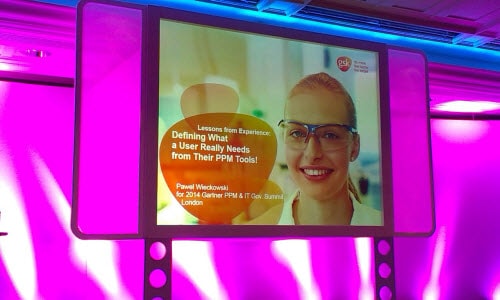What users want from project software: A case study

Pawel Wieckowski from GlaxoSmithKline presented a case study on their project software deployment at the Gartner PPM & IT Summit earlier this year.
He started off by saying that they defined who would be using the tool. Users, he said, fell into the following categories:
- Project management community
- Project Management Office
- Senior management
- The whole company
“A PPM tool is not just for the PMO,” he said, “it’s for use by the wider business community.” Therefore they had to find the right balance between user wants, what technology can deliver and business needs. “If you find the right balance you’ll be successful and everyone will be happy, but that’s not easy,” he said.
They were also clear on why they wanted to invest in technology by stating why it was needed. GSK needed a PPM tool because they wanted to simplify their data and have one repository. They wanted to also enable and empower the project management community.
Starting small
Pawel explained that they had the choice between a big bang roll out or an evolutionary approach and sensibly they chose to start small. They opted to roll out their solution, then refine it and optimise it later. They took an interesting approach to those refinements, too. The team gathered enhancement requests from users and then asked them to vote on them. Using this method meant that the user base set the priorities for enhancements.

Next steps
Three years on their solution is a tool that helps the company plan and realise its investments. One of the big refinements that Pawel explained was to plug the gap in corporate financial planning. The business has a complicated structure between bits of the company that deliver solutions and bits that fund projects. Any single project could be funded from a multitude of sub-companies or departments or countries and the PMO wanted to be able to see the impact of a project on one of these companies, countries or teams.
The business wanted projects linked to capital and operational plans so the team mapped the organisational structure and high level aggregated spend performance. They were then able to show the benefits and disbenefits of projects, where they hit, forecasted cost at completion, accurate actuals, along with high level and adjustable financial plans. In short, a really comprehensive way of looking at projects as investment spend.
Waterline spend
One of the key features was the ability to show a list of prioritised projects. The waterline is the amount the company can spend. It is marked on the project list and clearly shows which ones will be funded and which ones won’t which, Pawel said, is very useful for forecasting and for having difficult conversations with project sponsors.
You don’t need fancy software to do this – every PMO should have a list of projects that it can resource and a pipeline of projects that it would like to do next. Priorities change and so does the list, but you need some view in order to manage resources accurately.
Finally, Pawel said that his team had had to make many changes to the software, working alongside the vendor (and he didn’t tell us who it was, or if he did I didn’t write it down), in order to make their solution do exactly what they wanted. He recommended that we should all do the same and add the features we wanted even if they don’t exist at the moment. “Don’t hesitate to improve your tools,” he said. “PPM vendors will follow.”
